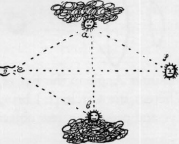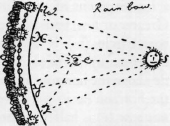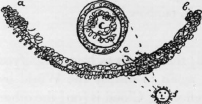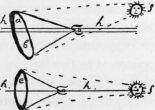Chapter 16
Of Appea[r]ing Meteors
APPEARING meteors (so call’d, besides those reall ones before mentioned) are treated of by the Antients under this head but indeed they discerve not the name of meteors nor are bodyes at all, but certain shews which bodyes by the help of light do Exhibit.1 [Of this kind are Numberd six.]
1. Chasm, or Gap in the heavens which is [either] lucid [or] dark.
1. Lucid [Chasm] is when [a] Luminous body is placed behind a stil cloud, thick in the Extreams, and thin, [or] parted in the middle, at which hole or Crevise the light breaking forth shows as if [the heavens] ware opened to discover the Glories [which are] above.
2. Dark [Chasm] is the Contrary when [a] dark spot is in the middle of a [bright] cloud, and then (as in painting) it shews like a deep well or pit as if a hole ware made through the [Skies] to look into the Abyss, both these may impose on a fearfull, and foolish fancy.
2. Halo is the hazy bright Circle about the [body] of the Sun, or Moon from a thin diffuced mist somwhat higher than Ordinary which when it condenses into Clouds soon after produces rain whereof the Halo is a Prognostiek.
3. [Parelius,] 2 or 3 Suns [(as it were) appearing at once,] tis when a still thick watry Cloud is so placed by the side of the Sun, that the reflection of the Suns face (as in a [looking] Glass) fals directly on our Eye. [Hence] then are 2 suns the true one, and the apparent, but in case another such Cloud is conveniently scituated on the other side of the Sun, to take (like a 2d Glass) [the] reflection [of] the first reflection [and cast] that also to our Eyes then have we 3 suns; and so we might have more if these Glasses or Clouds were sufficiently disposed
4. Parasylene is the same in respect of the Moon
5. Rods, or brushes are the rayes of the sun breaking forth at the hole of a Cloud [sidewise] to our Eye, which if it ware directly towards us [it] would be the lucid Chasm before mentioned.
Appearing Meteors, Chasms the dark, the light,
Halo, more suns, or moons, rods, rainbow bright.
6. Rainbow [either Solar or Lunar.]
1. Solar that is the most notable of [all] these kinds as being dignifyed to become a seal of Gods covenant not again to distroy the World by water, this is of kin to parelius only the reflecting Cloud is [on] the other side of [our Eye] opposite to the [Suns body] the rainbow therefore is nothing but a multiplyed reflection of the Sun from a dewy Cloud, or [a] gently falling rain the Eye being placed in a direct line between the Suns body and the Center of the circle whereof the rainbow is a Segment. Compare the diagram[s] in the parelius (e) the Eye sees the suns body (s) by the line (e s) the Suns reflection by the cloud at (a) is seen by the line (a e) the 1st reflection (a) is cast over upon the other cloud at (b.) and from thence seen by the line (b.e). In the rainbow (s) the Sun, shines on the Cloud (W, X, Y, Z,) where the [ray] that goes to (W) by the line (S W) points there the Immage of the Sun and reflects it to the Eye (e) by the line (W.e) So that at (X) by (X e) that at (Y) by (Y e) that at (Z) by (Z e) and so on if there be never so many; for the suns lustre is reflected to the Eye only from those points of the Cloud [51] where the Angles of insidence and reflection are Equall, and though indeed the whole Cloud be Illustrated yet hence it follows


1. That we see not the rainbow as composed of many distinct Suns, (as it is in the pareleus and as it is expressed in the rainbow Diagram) because the rayes of the Sun are a multitude more than can be expressed by lines; and therefore only some few of them are set down, and the rest left to Imagination. Whereas indeed every little bubble or drop reflects the whole body of the Sun in little; the Multitude of which being Close set togather seam to be but on[e] entire reflection. In the parreleus the reflection to our Eye is but from one part of the Cloud, whereas in the rainbow tis from every part that on all sides stand at the Dew angles with our Eye; and therefore if the Earth ware transparent, we should see it a whole Circle, and not a bow. Once I well remember I have seen such an Entire Circle standing on a Convenient ground for the purpose. There was a Long deep valley that ran (E. and W) and a Dewy Shower was falling into the Valley, about a Mile off Eastwards from my Eye which was upon the ascent of the hill, [on] one side of the Valley; Here the Eye (e) being in the line between (S.) the Sun and (C.) the Center of the rainbow the hallowness of the Valley between [the hills] (a. and b.) gave me liberty to See the Lower part of the Circle as well as the upper part thereof.

2. If the Cloud be nearer to the Eye the bow is [the] segment of a larger circle than when it is farther off; because it makes an obtuser angle in the Eye (According to the rules of Opticks) thus the Circle (a) makes a blunter Angle in the Eye (e) and there presents to it the biger object. Whereas the Circle (b.) being more remot makes a Sharper angle in the Eye and presents a less object thereunto.

3. If the Sun be high above the horizon (h h) then the bow will be a less Segment of the Circle (be [the Circle] Greater or less) because the Greater part of the bow-Circle (b.) is under the horizon (h.h.) therefore (a) the rainbow appearing is but a little above the horizon. But if (S) the Sun be near the horizon (as in the lower diagram) then the rainbow (e) is half the Circle, and therefore high above the horizon (h.) because the Centre of the Circle is [also] in or near the Horizon.

4. The Bow is still opposite to the Sun and therefore is never seen at high noon unless in winter when the Sun is low; then indeed a little [bit] of a rainbow may be seen in the north (Commonly Call’d the Dogs Eye in the N.) A Prognostiek of cold stormy weather but where and when the Sun is vertical or drawing [near] thereto, (as tis in our summer dayes at noon) there can be no rainbow because all the Circle would be under [the] horizon.
5. If 2, or more of these bows appear the 2d is but the reflection of the first (as in the parrallius) and the 3d (more Languid) is the reflextion of the 2d etc: This appears by the Inversion of the Collours (according to the laws of Opticks) the Quite contrary way from that from which it was reflected.
6. The Collours of the Rainbow are purple, Red, Yellow, Green, blew, according to the variou[s] reflections, and refractions of light on the watry drops, the like we may See on the drops of dew; on a dimond; [or] a broad stream of falling water, where it has Some transparency of the light behind it, and Especiall[y] in the trigonal Glass from whence Mr Boile Illustrates the nature of Colours in his book on that Subject. Now that Colour of the Rainbow which is nearest the Centre and partakes more of light, or reflects it more fully to our Eye Gives the Suns Immage more red (purple or rutilous) that which is next to it may be conceived to be reflection from drops a little farther off; and Yellow is more languid than red; the utmost is blew which requires but a little light; and between the blew and Yellow is Green; which is a mixture of the blew and yellow, as we commonly see in a painters mixing of Colours.
7. The Prognostication of Rainbow is rain if it appears in the Evening; because the nights cold will farther condense the Clouds; but in the morning it foreshews a fair day because the dayes heat will rarifye the [Cloud] according to the old Saying.
A Rainbow in the Eve; put thine head in the Sheave,
A rainbow in the morrow; go take thy bow, and arrow.
Besides this natural signification it has also another instituted to as-[52] sure us of Gods Engagement, and purpose to moderate rain for the Use of man, and not to distroy again the Earth thereby. A Question is Usually put whether the bow were in nature before it was spoken [of] in (Genesis. 9.)? the Answer is Affirmative for the Natural cause of it was from the beginning. Therefore the Words (I Will put my bow in the Clouds) signifyes I will put it as a sign of my covenant, and not add a new creature to the nature of things.
Rainbow which dos no native beauty want,
Is more illustrious by Gods covenant.
2. The Lunar Rainbow is of the same nature and from like causes but with these differences.
1. The figure of it is a whole Circle about 15 or 16 Degrees from the moons body (Round about it) more or less according to the height of the Cloud.
2. The Cloud is between our Eye and the moon, [not] opposite as that of the Sun is; therefore it is nearer of kin to the parasalene, than the Suns rainbow is to the Parelius.
3. The Cloud is more thin and the moon shines pretty bright through it.
4. And therefore the Colours of it do scarce at all appear but only as a Whittish Circle somtimes edged with a pale purple; the natural pale Colour of the moon likewise contributing thereto.
5. The Prognosticks of this (as of the halo) is by the Colour; if more pale tis rain, If more redish tis a stormy wind; but if a more bright white; it commonly preceeds good wether.
Moon Circling rainbow doth pre[s]age we find
Wet weather pale; fair white; and reddish wind
And thus much of the bodyes call’d by the antients [imperfectly] mixt; namely meteors.
